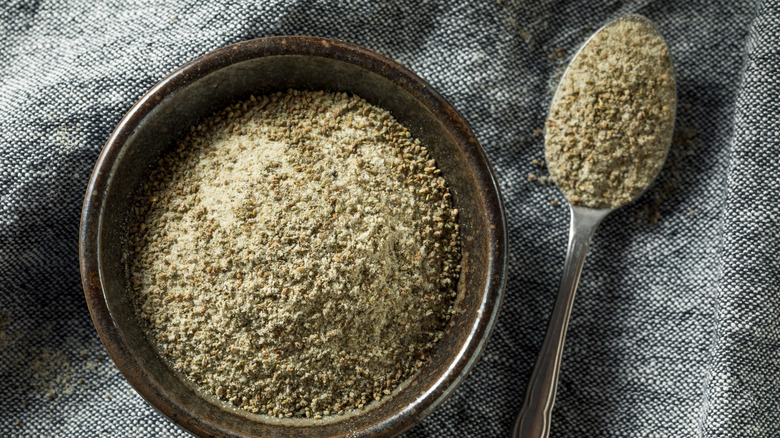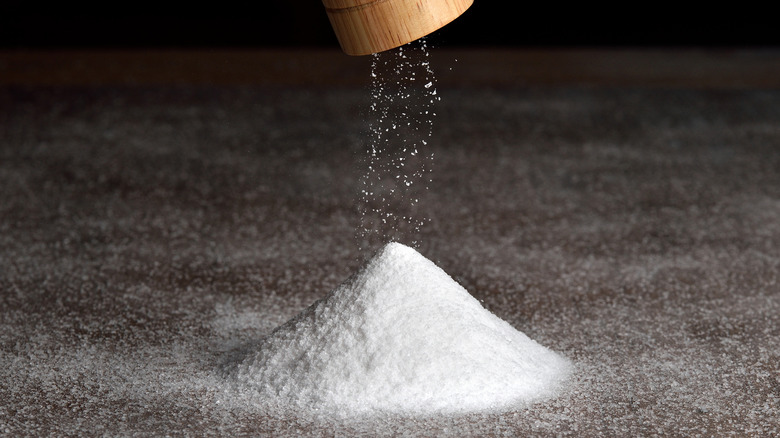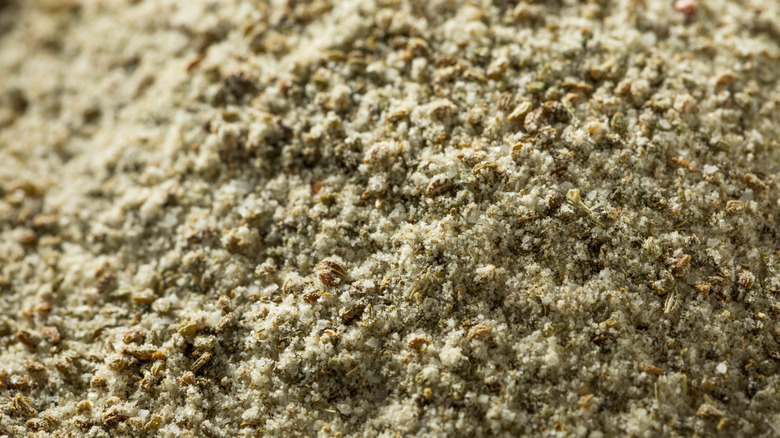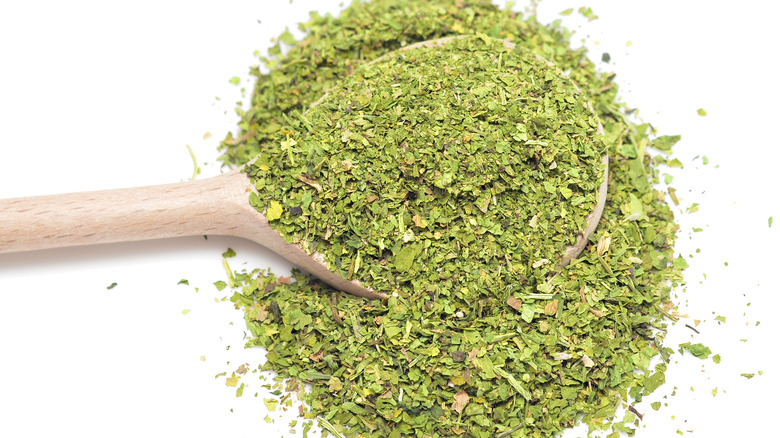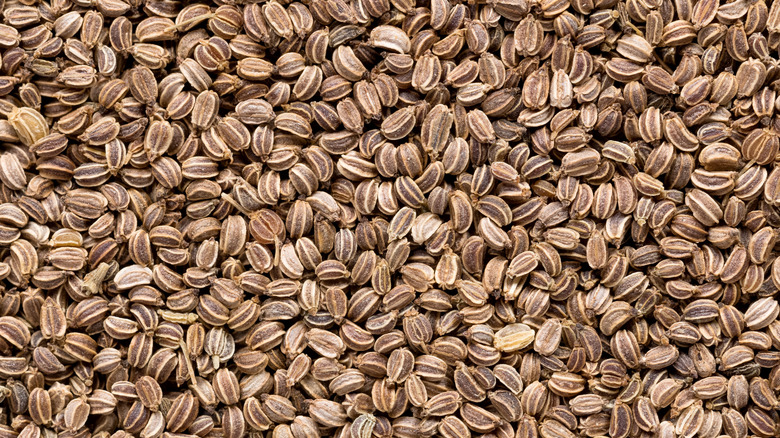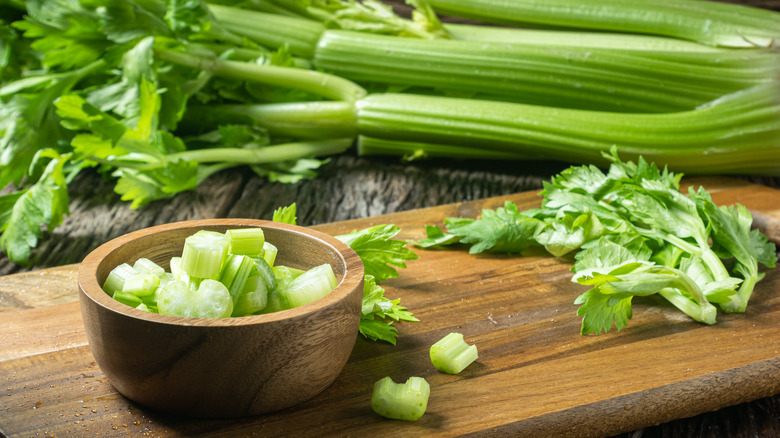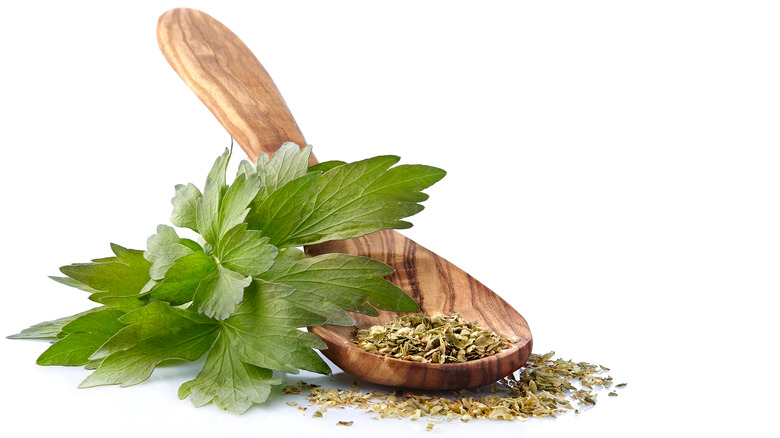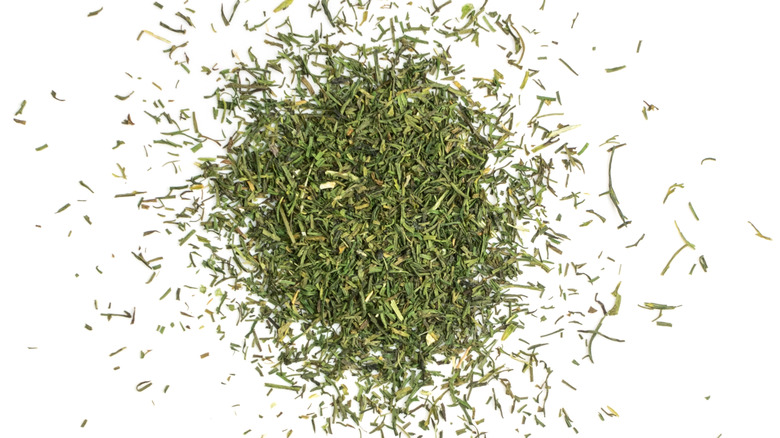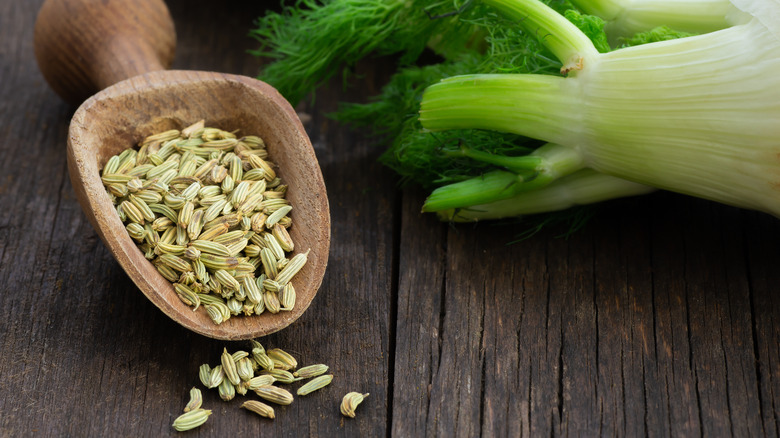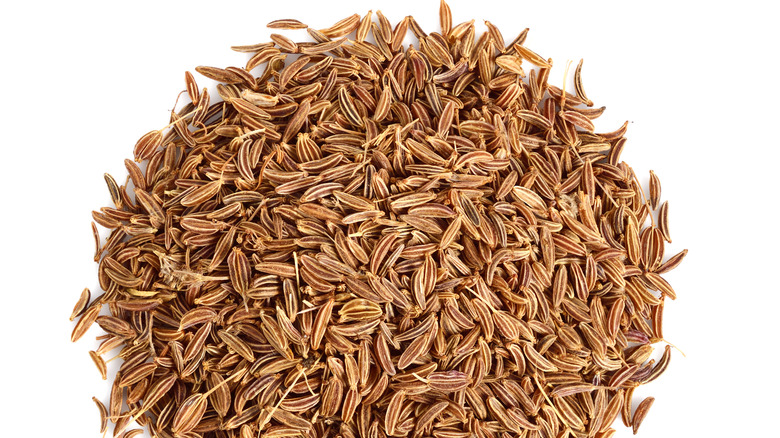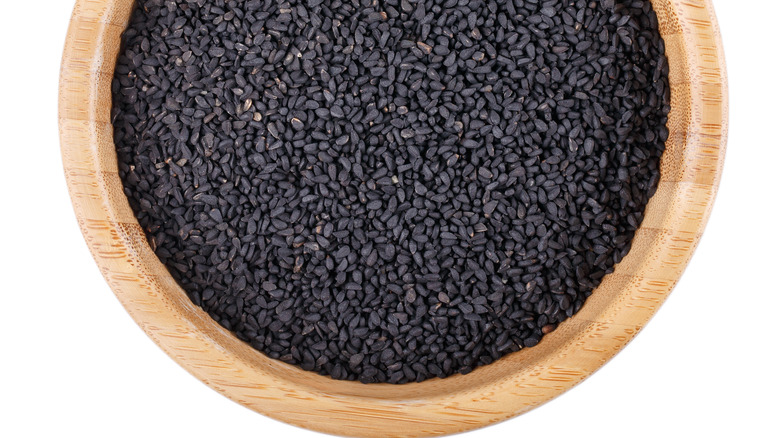10 Best Substitutes For Celery Salt
For anyone who loves to cook, having a fully stocked spice pantry is a must. Spices bring a dish to life by adding distinct flavors and richness to a meal. Oftentimes, a particular ingredient can turn an ordinary dish into something that really shines. There are also spices that are used frequently at restaurants and in home kitchens but may go unnoticed unless you're privy to the flavor. That's the case with celery salt. It's a common ingredient in a lot of recipes, such as potato salad, coleslaw, popcorn, and even the Bloody Mary, but not everyone knows it by name.
Most people have salt in their kitchens, whether that's table salt, sea salt, Himalayan salt, or fleur de sal; salt can turn a bland dish into a shining star. But what exactly is celery salt? Simply put, it's crushed celery seeds that offer hints of celery flavor, combined with salt.
It's easy to buy celery salt in the spice section at any grocery store, but if you like to DIY, you can easily make it yourself by grinding celery seeds and mixing them with salt. The blend is typically a ratio of 2:1, according to Allrecipes. If you don't have celery salt on hand, though, there are a few other ingredients you can use in place of it.
1. Salt
If you're in a pinch and find yourself without any celery salt, you can always forgo the celery and just opt for your salt shaker. Obviously, you won't have those earthy, grassy flavors of celery, but regular salt will still suffice. The Kitchen Community suggests considering different types of salt, such as a fine or coarse salt, depending on if you want to add some texture to your recipe.
If you've had a long day at work and don't feel like running out to the grocery store, or you started cooking later than you anticipated and all the nearby grocery stores are closed, don't fret — just use regular salt this time. To add in some peppery hints, mix salt with some pepper to mimic the taste of celery salt, suggests The Breslin.
Use the same measurement that you would use if you were using celery salt — a 1:1 ratio, per The Kitchen Community.
2. Celery seeds and salt
If you have celery seeds in your spice cabinet but you don't have any celery salt, this is an opportune time to create a homemade blend. You'll want to use a mortar and pestle or a grinder to pulverize up the celery seeds before mixing them with salt. As for what type of salt to use, you can go with whatever you have on hand, though Cuisinevault recommends using kosher salt.
One of the benefits of grinding celery salt at home is that the spice will be at its freshest; unlike a store-bought bottle, it hasn't been sitting on shelves for a while, per Bake it with Love. The goal is to turn the celery seeds into a fine powder so it's similar in texture and size to the salt.
As far as measurements go, The Breslin suggests using one teaspoon of celery for every two teaspoons of salt.
3. Celery powder
If you don't have celery seeds, celery salt, or fresh celery but you find a jar of celery powder hiding in your spice cabinet, there's good news. Celery seeds are stronger and more potent in flavor compared to celery powder, which has a milder flavor. But it's still a good substitute for celery salt.
Celery powder is made by dehydrating celery stalks and leaves to create a fine powder, explains The Kitchen Journal. Some versions of celery powder are made from celery juice, while others are made from ground celery seeds, per SPICEography. If you're up for some DIY and you have a vegetable dehydrator at home, you can also make a homemade version.
Typically, celery powder is used for meat rubs as well as curing meat due to its nitrates. A wonderful seasoning for meat or seafood dishes, celery powder is a great addition for sauces, soups, salad dressings, stews, and even casseroles, per The Kitchen Journal.
When it comes to using celery powder as a substitute for celery salt, the ratio is 3:1, or if you want a specific measurement, 3 teaspoons to 1 teaspoon, suggests The Foods Guy. Keep in mind that you may need to add a bit more salt to your recipe, as celery powder won't have the same amount of salt as celery salt does.
4. Celery seeds
Celery seeds, which usually come from wild celery, are also sold in the spice section and are used as a seasoning for many savory dishes. Blackish and brown in color, celery seeds are tiny like poppy seeds and have an earthy and sometimes slight bitter flavor, according to Healthline.
Wild celery seeds are considered to have a stronger flavor than the common variety of celery. These seeds are produced at the end of the celery plant's life cycle and are the same seeds used to plant and cultivate more wild celery.
These flavorful seeds are often used in sauces, salad dressings, marinades, spice mixes, and spice rubs. You can choose to use the whole seed or grind them up before using them in your recipe, per Food Champs, but oftentimes, it will depend on what you're making. Marinades, dressings, and rubs are best in whole seed form, but if you're preparing a silky soup, sauce, or a condiment like ketchup, you'll likely want to grind the seeds beforehand, per Simply Recipes.
When substituting celery seeds for celery salt, the ratio is 1:1, according to Food Champs.
5. Celery leaves and stalks
Celery is a vegetable that is often classified as an aromatic, similar to carrots and onions. It's also an important ingredient for mirepoix, a classical base for many cuisines.
Using the leaves and stalk of celery is an option if you're wanting to capture some of the grassy, earthy notes of fresh celery. However, celery seeds will have a stronger and more condensed flavor than the leaves and stalk, per Substitute Cooking.
This substitution works well if you're cooking a dish and want to layer in the flavors. Not only will the fresh celery add a nice flavor with a touch of sweetness, but it will also add texture because the stalks are fibrous. But if you're looking for a powdered substitute, this option won't be a fit.
As a rule of measurement, for each 1 teaspoon of celery salt called for in a recipe, you'll use 6 teaspoons of finely chopped celery leaves and stalks, according to The Foods Guy. Substitute Cooking recommends using a 2:1 ratio of salt to fresh celery for the best results.
6. Lovage
Lovage is part of the celery family, known as Apiaceae, and it's often considered a wild celery. But while celery and lovage have similar characteristics, they aren't the same. Lovage's flavor is often likened to that of licorice or anise. And The Foods Guy says it has are hints of lemon, while Substitute Cooking suggests the flavor is a mix of anise and parsley.
Lovage leaves and roots can be used in dishes such as salads, soups, sauces, or stews. Meanwhile, lovage seeds are typically added to baked goods, such as breads, cookies, and pastries.
Lovage seeds have a stronger flavor than celery seeds, so keep this in mind when lovage using as a celery salt substitute. However, these are typically used interchangeably when substituted, so you can use them in equal measurements.
If you want to make a salt mixture, combine one part lovage seeds with two parts salt with a ratio of 1:2, recommends Substitute Cooking. You can also use dried lovage leaves instead of seeds.
7. Dill and salt
Dill is an herb that's often used as a seasoning for salmon or to make savory dill pickles. Dill is a fragrant herb that's part of the plant family of celery, per Cooking Chew, so it can be a natural alternative if you don't have celery salt or celery seeds available. A versatile ingredient, dill is often used dried or fresh. In addition to being a common pairing for salmon, dill can also be used with other seafood as well as sprinkled into dips, sauces, and soups, per Substitute Cooking.
Dill salt can be wonderful as a rub for meats, sprinkled into salads, or added to marinades or dressings, per Cooking Chew. Making homemade dill salt is easy and requires just two ingredients: dill and salt. You'll want to grind the dill, either in a spice grinder or mortar and pestle, so that the texture is a fine powder before combining it with equal parts salt.
Then, place the dill-salt mixture in a glass jar or reusable spice bottle to add this dill salt to your spice pantry. And if you're substituting dill salt for celery salt in a recipe, the ratio is also 1:1, according to Cuisinevault.
8. Fennel seeds and salt
Fennel is a part of the carrot family, and both the bulb and seeds can be used in recipes. Fennel is used in a myriad of savory and sweet dishes and can be prepared in a multitude of ways, including braised, grilled, sautéed, stewed, or even chopped raw to be used in casseroles, curries, salads, pasta, soups, and sauces, according to Substitute Cooking. Fennel seeds are common in Indian cuisine, especially in curries. The seeds are also a common ingredient in sausages, in herbal teas, and baked goods.
To make fennel seed salt, grind the seeds first before combining with salt. This mixture is ideal as a rub for meats, Italian dishes, and other hearty meals, per The Foods Guy. However, fennel's anise or licorice flavor profile won't be ideal if you're looking for a celery salt substitute for your Bloody Mary, as the flavor will alter your beverage. Consider other substitutions if you're planning on making this drink.
The ratio for making fennel seed salt is 2 parts salt to one part fennel seeds, per Substitute Cooking.
9. Caraway seeds and salt
Caraway seeds have a sweet and savory flavor with a touch of anise or licorice flavor. They also have a hint of citrusy notes and pepper, too, per The Foods Guy. A common ingredient in many baked goods, caraway seeds are often used in rye bread. A versatile spice, caraway seeds are often added to an array of dishes, including curries, soups, salads, and vegetables.
If you're looking for a celery salt substitute for meat dishes or vegetables, caraway seeds are a safe bet, notes Cuisinevault. However, if you're looking for a substitute for celery salt for your Bloody Mary, you won't want to opt for caraway seeds, either as it won't provide the flavor profile you seek.
To make a caraway seed substitute for celery salt, combine 2 parts salt to 1 part caraway seeds, suggests Substitute Cooking. Grind the seeds in a spice grinder or mortar and pestle before blending them with the salt.
10. Nigella seeds
Another alternative for celery salt is nigella seeds. These black, small seeds can have a touch of bitterness, per BBC Good Food. They also have peppery notes and sometimes a nutty flavor, according to Herbies Spices. They add a nice aroma and flavor to most dishes and are readily available in the spice section at the supermarket or Middle Eastern grocery stores. Nigella seeds go by many names, including kalonji, black cumin, or black caraway, per Britannica. Sometimes, they're called black onion seeds based on the size and oval shape, although they have no relation to the onion family, BBC Good Food notes.
Nigella seeds are common in Middle Eastern, Indian, and North African cuisine and are usually used in savory dishes, such as curries, squash based dishes, or lentils, as well as breads such as naan, per MasterClass. When considering nigella seeds as a substitution for celery salt, they're ideal for soups and stews.
When you're measuring just how much to substitute, the ratio is the same: equal parts celery salt for nigella seeds, according to The Breslin.
